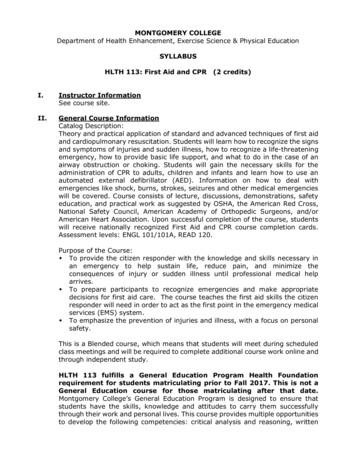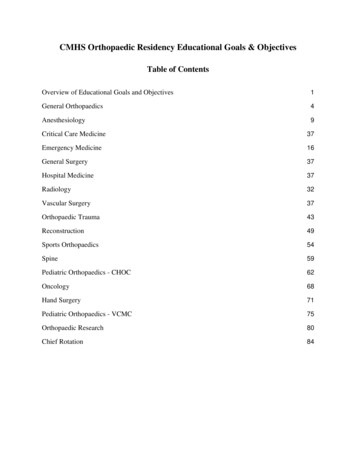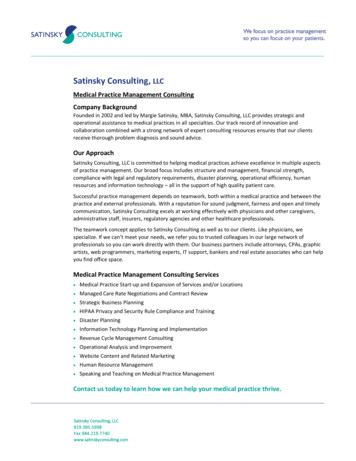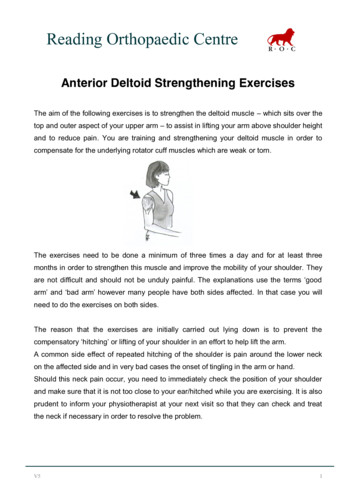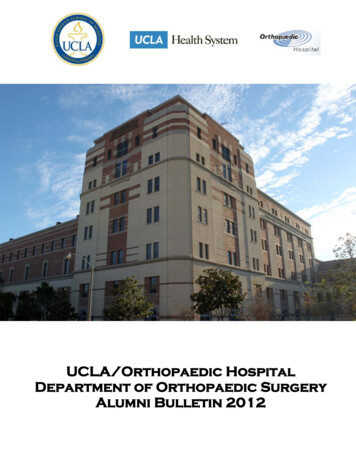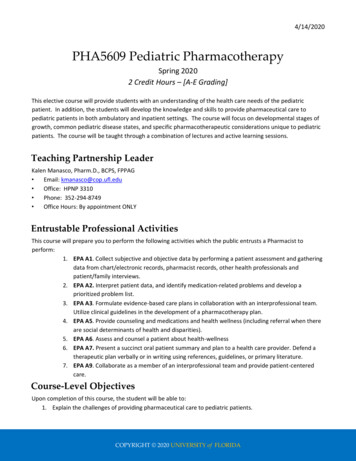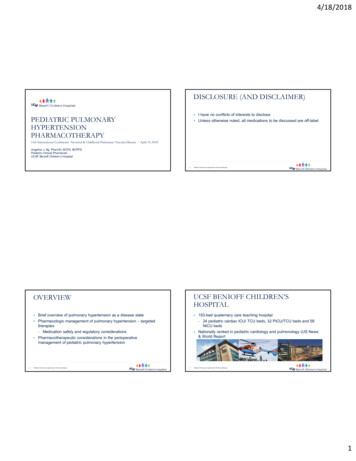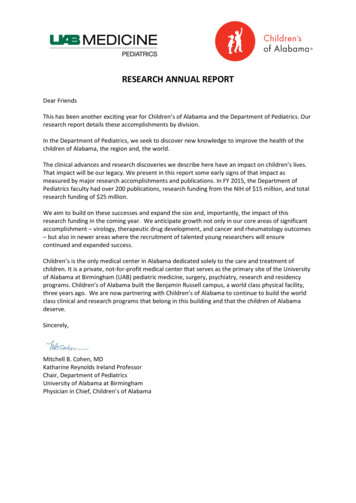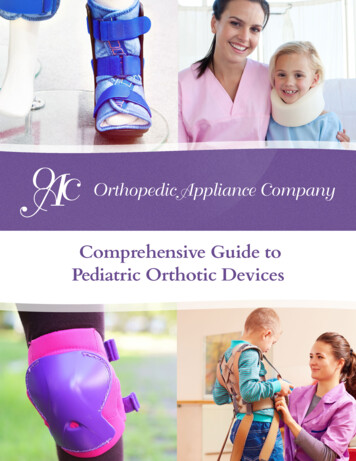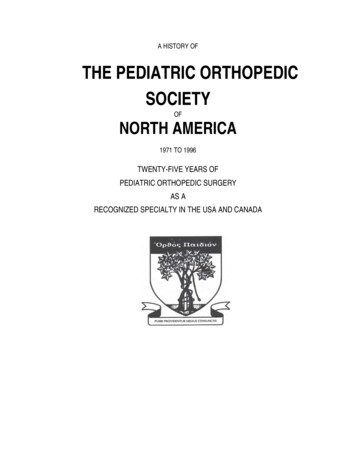
Transcription
A HISTORY OFTHE PEDIATRIC ORTHOPEDICSOCIETYOFNORTH AMERICA1971 TO 1996TWENTY-FIVE YEARS OFPEDIATRIC ORTHOPEDIC SURGERYAS ARECOGNIZED SPECIALTY IN THE USA AND CANADA
A HISTORY OFTHE PEDICATRICORTHOPEDIC SOCIETYOFNORTH AMERICA1971 TO 1996TWENTY-FIVE YEARS OFPEDIATRIC ORTOPEDIC SURGERYAS A RECOGNIZEDSPECIALTYIN THE USA AND CANADABYDr. Hugh G. Watts, MD
I) THE ORIGINS OF POSNA:The history of the Pediatric Orthopedic Society of North America is tightly intertwined with that of thedevelopment of pediatric orthopedics * as an organized specialty throughout the world. Consequently, itis easiest to discuss both elements as they relate to the remarkably rapid series of events that have takepediatric orthopedics from virtually non-existence to a prominent position of an established specialty** oforthopedic surgery in about twenty five years.A) The Pediatric Orthopedic Society (POS):Prior to 1969, the practice of orthopedic surgery restricted to children alone was an unusualphenomenon. Although many orthopedists had a special interest in the treatment of children, there wereonly a handful of orthopedic surgeons who looked after children exclusively.In 1969, Drs. Douglas McKay then of the Shriners Hospital in Shreveport, Paul Griffin then ofNashville and Mihran Tachdjian of Chicago believed that there was a place for an organization wherepediatric orthopedists could discuss problems which were of special interest to those treating children. Inthe historian's report of November 1975, Dr. Burr Curtis stated that"It was not clear who among this group generated the original idea, however, Dr. Douglas McKaywas responsible for bringing this group together in January 1970" .at the AAOS meeting in San Francisco. However, in 1995 Dr. Anthony Bianco Jr. remembers that. . ."The real spark plug in putting the organization together was Mike Tachdjian. He did the early hardwork and kept us all interested. "The first meeting took place in Dr. McKay's hotel room together with Drs. Griffin and Tachdjian aswell as Drs. William Green of Boston, Burr Curtis of Newington and Frank Stelling of Greenville SC.Initially, they were able to list nine orthopedic surgeons (which they later were able to expand to twelve)who mostly restricted their practice to children.On June 4 and 5, 1971, a more structured organizational meeting was arranged to see if a society ofpediatric orthopedists could be established. This took place in Chicago at the Children's Hospital, with Dr.Mihran Tachdjian hosting and Dr. McKay presiding. 1\vo informal clinical sessions were held as well asthree organizational meetings. The meeting was attended by Drs. Anthony Bianco, Burr Curtis, WilliamGreen Sr., Paul Griffin, Dean MacEwen, Douglas McKay, Robert Samilson, Frank Stelling, and MihranTachdjian. Drs. Sherman Coleman, Wood Lovell and Charles Ryder had been invited but were unable toattend.Several of those present, especially Dr. Green, felt that it was important not to isolate children'sorthopedics from general orthopedics, however, the mood of separatism prevailed and a new society wasborn. Officers were elected: Drs. William Green, President; Burr Curtis, President-elect; Douglas McKay,Secretary; Paul Griffin, Treasurer; plus Frank Stelling and Robert Samilson as Members-at-Large on theBoard of Directors.*Many who have kindly reviewed this history have commented on my varying spelling of "orthopedic" versus "orthopaedic",I have used the spelling "orthopedic" (my preference) except where it is a direct quote. See page 44 for further discussion of thissemantic argument that will probably nag us till Nicolas Andry rises from his grave,**.Originally, I used the term "sub-specialty", I have taken the suggestion (a most apt one) of Dr. Michael Goldberg to " eliminatethe term sub-specialty and just to refer to pediatric orthopaedics as a specialty, We are subservient to no one".
The next gathering was held at Newington Children's Hospital September 10th and 11th 1971 followingthe Scoliosis Research Society meeting. This meeting 'was declared as "the first" official meeting of thePediatric Orthopedic Society. It was attended by twelve orthopedic surgeons. Drs. Bianco, Coleman,Curtis, Green, Griffin, Lovell, MacEwen, McKay, Ryder, Samilson, Stelling and Tachdjian. It was agreedthat nine additional members be invited to join. . Drs. William Donaldson and Albert Ferguson ofPittsburgh, John Hall and Arthur Pappas of Boston, Alvin Ingram of Memphis, Robert Salter of Toronto,Howard Steel of Philadelphia, John Wilson Jr. of Los Angeles, and Robert Winter of St. Paul.In the early days, those interested in pediatrics were scattered, and not well known to each other. WhenDr. John E. Hall of Boston, but recently moved from Toronto, was made a member, he was entered on therolls as Dr. John I. Hall of Georgia. This delayed, considerably, the organization of a panel discussion forthe annual meeting of 1975 when all of the correspondence was first sent to Georgia.The first members of the POS seemed to have a monastic bent. Wives were to have been excluded fromcoming to meetings on the thinking that such serious business required "total-immersion". However, thisabstemiousness lasted for only three meetings. By the 1977 meeting in Palm Beach FL, when Dr.Tachdjian was president, joie-de-vie predominated. According to Dr. John Hall. ."Mike Tachdjian was the chairman. He arranged a dinner at a very fine restaurant and I remembereveryone remarked what a fine wine he had chosen. It wasn't until later that we found out why it was sogood, when we discovered that the dinner had bankrupted the society"The first official printed stationery appeared in 1974, however it was bereft of a logo. The matter of aLogo consumed a great deal of time and interest. Sample offerings were passed around and from thesubsequent letters it was clear that many of the members felt that there was certainly no concordancebetween skills in pediatric orthopedics and artistic talent or sensibilities. "Awful!" was one response. Dr.Burr Curtis then made an offering to which Dr. Howard Steel suggested ("with tongue-in-cheek andtwinkle in my eye") "Why not incorporate the della Robia which has become synonymous with pediatric practice, withAndry's tree which seems to be ours, and meld the ropes that bind the crooked tree to the straight stakeinto the swaddling clothes of the infant?"Dr. Robert Salter, horrified at the thought of promoting swaddling, wrote. . .As one who has been interested in the preventive aspects of congenital dislocation of the hip and whofeels that the habit of binding newborn hips in the position of adduction and extension is deleterious tothose infants who have unstable hips, I cannot help but raise the question of whether Andrea dellaRobia's figure of the infant in swaddling clothes is appropriate on an emblem of a society thatpresumably is just as interested in prevention as in treatment".The solution was to put the matter into the hands of a committee chaired by Dr. Robert Samilson.Finally, a logo was chosen with the intention of showing the importance of growth as the main featurethat distinguished the interests of pediatric orthopedics from that of the parent body.
pediatricorthopaedicsocietyInitially, the society was very restrictive in order that the discussion of problems would be at a highlevel by people with a great deal of experience. It was recognized that many orthopedic surgeons who hadmade significant contributions to pediatric orthopedics did not necessarily limit their practice exclusivelyto children, however, the feeling was that membership should be based upon demonstrated interest andcontributions made to the clinical management, teaching, or research in pediatric orthopedics. Althoughnever written, there was a policy that there would only be one member from each of the well-knownpediatric orthopedic institutions. This policy was a major impetus to the later establishment of thePediatric Orthopedic Study Group since there would be little likelihood of membership for orthopedistssuch as Drs. Hamlet Peterson or Henry Cowell who were in the first assistant positions at that time. As ithas turned out, their senior partners are very much alive today and only recently retired. Drs. Peterson andCowell would have had a tedious twenty five year wait. Recently, Dr. Anthony Bianco Jr. wrote to say. . ."1 can't help but wonder what would have happened if the ridiculous rule about not having twomembers from the same institution had never come up. I think that the. organization of the PediatricOrthopaedic Society would have been much smoother."Membership was firmly established to be by invitation. Dr. McKay, as secretary received so many lettersof application that he was forced to draft general letter stating that membership was by invitation. Thisrestriction put the society at odds with the principles of the American Academy of Orthopedic Surgeons.The POS members specifically chose not to affiliate with the AAOS rather than to open the membershiprolls which such an affiliation would require. In 1972, the members voted to limit active members tothirty five and in 1973 to increase the membership "by no more than five per year".The membership restrictions kept even Dr. Walter Blount out of the organization because his practicewas not exclusively with children. The issue was corrected when, in 1991, he was honored by POSNA asa "Pioneer" because of his tremendous contributions to pediatric orthopedics. Dr. David Sutherland, whowas the Historian at that time noted."1n a taped response to the members in 1991, he (Dr. Blount) said rather plaintively that when thePediatric Orthopedic Society was established '1 thought that it would really be my cup of tea.' He wasdisappointed that he was not invited because of his practice profile."By 1974, some had recognized that this exclusivity was inappropriate in that there were many youngpediatric orthopedists who were coming along who needed a forum for discussion. Dr. Robert Winter,who succeeded Dr. McKay as Secretary of the POS, was a strong advocate urging the other members towiden the scope of admission. As a consequence, the membership was somewhat begrudgingly opened upagainst a strong contingent who maintained that a high standard required careful selectivity.
B) The Pediatric Orthopedic Study Group (POSG) :In 1974, Drs. Hamlet Peterson of the Mayo Clinic and Henry Cowell of the duPont Institutebelieved that the young pediatric orthopedists needed their own forum. After a meeting which took placein a hotel room during the 1974 AAOS annual meeting in Dallas, they sent out a letter inquiring aboutinterest in such a gathering. Three months later, in July, a follow-up letter was sent:"Dear Doctor:"Three months ago a letter was sent to you inquiring about your interests in meeting with otherorthopedists interested in pediatric orthopedics. A positive response was received from nineindividuals. Though more participants would be desirable, the individuals who did respond indicatedthat this type of meeting has definite. merit and would be worthwhile. Therefore, a one-day meeting inthe Fall is planned in hopes that attendance will include all who responded positively as well as somewho did not respond."In an attempt to avoid conflicts, Monday November 4 has been chosen as the day for themeeting. The meeting will be held at the Mayo Clinic in Rochester, Minnesota and would be limited toone day. As you recall each person attending is requested to present some subject related to pediatricorthopedics. Please let us know soon if you are interested in this meeting and indicate the subject ofyour presentation and the amount of time desired."If you know of anyone else who might be a candidate to attend this meeting, let us know, We willcorrespond with you as soon as the results of this letter are known"The mailing list for this letter included: Drs. Virginia Badger of St. Louis, Walter Bobechko of Toronto,Stanley Chung of Philadelphia, Liebe Diamond of Baltimore, James Drennan of Denver, Robert Eilert ofDenver, Robert Fisher of Newington, Roger Gallien of Quebec City, Robert Hensinger of Wilmington,Rudoiph Klassen of Mayo Clinic, Stephen Kopits of Baltimore, Dennis Lyne of Chicago, MaureenMalloy of Boston, E. William Schmitt of Atlanta, George Simons of Chicago and Lynn Staheli of Seattle.(The frequent changes in location, for which pediatric orthopedic surgeons have been known, can be seenby comparing the above addresses with current ones.)Again with this new group, the individuals scattered over the continent were not well known to eachother. Dr. James Drennan was listed as Robert Drennan for several years. In reply to Dr. Peterson'srequest for additional names of people who might be interested in joining, Dr. George Simons wrote. ."The only person I know of in addition to those mentioned in your list is the fellow who works at theUniversity of Miami. I believe his name is Newton McCullough. "So much for Dr. McCullough who later became president of POSNA and thenof the AAOS.It is interesting to note that this first group of POSG members listed three womenwhile no women were ever invited to become members of the POS. (Currently, thereare thirty eight women who are active members of POSNA representingapproximately 8% of the active members).
The early exploration for other interested pediatric orthopedic surgeons was both timid and a littleparanoid *. Drs. Cowell and Peterson were aware of the consternation that this upstart group was creatingamong some of the POS members. They did not want to have ."the initial meeting in conjunction with the Academy or an Instructional Course since there would bemany members of the 'other group' ".Dr. Staheli had suggested a two day meeting as being more efficient use of time. However, the choiceof a one day meeting for the initial gathering, was chosen specifically to keep a low profile. Dr. Petersonreplied to Dr. Staheli. . ."The proposal for this meeting is met with considerable resistance and a sense of antagonism fromseveral individuals. It is not wise to elaborate on this point at this time since you are probably aware ofthe situation.However, Dr. Cowell states that. . ."Rather than the choice of a one day meeting being made to keep a low profile, the one day meetingwas chosen as Ham and I did not believe that nine attendees could present enough material to have atwo day meeting"As a consequence, the "Pediatric Orthopedic Travel Group" (their initial name) was established andbegan with a meeting in Rochester, Minnesota in September 1974 (not in the living room of Dr.Peterson's home as fable has it) but in a conference room at the Mayo Clinic with nine attendees. Drs.Cowell and Peterson as well as Badger, Eilert, Gallien, Hensinger, Lyne and Simons. Also there was Dr.Rudolph Klassen of the Mayo Clinic. Because there were only seven at the one day meeting, each personwas allowed all the time they wished for their topic, and a great deal of discussion ensued.The group had been drawn together as a reaction to the restrictions of the Pediatric Orthopedic Society.As a consequence, the spirit .of the gathering was one of openness of membership, and informality oforganization. By the second meeting, the name had been changed to "The Pediatric Orthopedic StudyGroup" (POSG). It was originally directed by "co-chairmen" rather than a president. The only strongregulation was that each person attending a meeting had to present a paper. As the organization grewrapidly, the requirement which insisted that each attendee present a paper and the strong desire to allow asmuch discussion time as possible led to the development of a rapid-fire program format where subjectswere brought up for 4-5 minutes of formal presentation followed by 10-20 minutes of discussion time.*. After graciously reviewing this manuscript, Dr. Henry Cowell replied."First let me note, parenthetically, that some days it is not paranoid to be paranoid. Nonetheless, I believe that it is incorrect tocharacterize our early exploration as 'timid and a little paranoid'. Ham and I actively sought other individuals who were practicingpediatric orthopaedics. I would concur that a number of the people we approached seemed paranoid, most likely because they weretold not to participate in the POSG. I myself was told to carefully consider whether I wishedto participate or not. as my participation might reflect poorly on my future career. Thus one might consider Ham and Iirrational for proceeding; however, the word timid is not appropriate."
Growth brought its problems to the POSG as well. The membership ballooned and they, too, began todiscuss, as early as 1976, restricting the number of members.'At the rate we're going we might have to rent out the Rose Bowl for the next meeting' wrote Dr. EWilliam "Butch" Schmitt of Atlanta.Openness won out, but a requirement was instituted that members had to spend 75% of their timetreating children. In addition, membership in the American Academy of Orthopedic Surgeons was made arequirement. Since membership in the Academy necessitated several years of practice after the end ofresidency, it was anticipated that those less committed to pediatric orthopedics would becomedisinterested and drift away, thereby decreasing the stress on growth.When Dr. E. William "Butch" Schmitt of Atlanta became the Secretary-Treasurer in 1975, he followedthe advice of his lawyer sister and proceeded to put POSG on a more organized footing. This includedmaking the POSG a formal legal entity incorporated in the State of Georgia. The second meeting was heldin Atlanta with 18 attendees, co-chaired by Dr. Cowell, Peterson and Staheli. Those in attendance were:Dr. Marc Asher, Virginia Badger, Stanley Chung, Harry Cowell, Liebe Diamond, James Drennan,Edward Eyring, Richard Gross, Robert Hensinger, Walter Huurman, Rudolph Klassen, Dennis Lyne,Hamlet Peterson, Louis Roy, Robert Rosenthal, Lynn Staheli, Kaye Wilkins, and E. William Schmitt.The organization now was clearly established. The enormous work done by Drs. Cowell, Peterson andSchmitt throughout the period was recognized by the members who, in 1980, presented special plaques toboth honor and thank them for their efforts.The two societies, POS and POSG appear to have had a different historical sense of themselves.Reviewing the minutes and letters of the early years of the Pediatric Orthopedic Society, there is a clearsense that its members believed that their activities were of historical significance. By the fourth annualmeeting an historian was elected (Dr. Burr Curtis) who presented a report to the members by November1975. Formal group photographs were taken of the members gathered together at each annual meeting.By contrast, the records of the early events of the Pediatric Orthopedic Study Group are skimpy. Onlyprograms of annual meetings for 1976, '77, '78 & '79 have survived.The POSG members appeared to have believed that they were a small specialized group like the many"Travel Clubs" that sprouted in the American orthopedic world from the '40s to the '70s*.By 1979, some of the members of the POSG began to feel that this new organization was one whichought to have greater aspirations than just that of a "travel club", They suggested the name be changed toone more befitting an organization of significance. In addition some members were having difficultygetting funding from their parent institutions if they were going to attend a meeting with a name whichdid not suggest a real organization. To explore the issue, Dr. Staheli surveyed the members by mail. Theresults showed the following:*Dr. Cowell states that. . ."From the historic standpoint, I believe we felt more like 'young turks' at this stage, and not a travel club. The name waschanged from the Pediatric Orthopaedic Travel Club to the Pediatric Orthopaedic Study Group by the second meeting, aswe believed that we were a group concerned with education and study, rather than with travel. "
Leave name as is: 36Change name to. . .Association of Pediatric Orthopaedists 26Academy of Pediatric Orthopaedics5Pediatric Orthopedic Association 5Organization of Pediatric Orthopaedists 2And one vote each for. . .College of Pediatric Orthopaedists,American Assoc. of Pediatric Orthopedic Surgeons, International Organization of PediatricOrthopedic Surgeons, Pediatric Orthopedic Research Society;Assoc. for the Study of Pediatric Orthopedics,International Assoc. for Study of Pediatric Orthopedics,Assoc. of Pediatric Orthopedic Surgery,Assoc. for Orthopedic Surgeons for Children,American Academy of Pediatric Orthopedics,Children's Orthopaedic Assoc.,Assoc. of Pediatric Orthopaedic Surgeons.So the name of the organization was left unchanged. (The remainder of the survey showed that themembers wanted, in regard to "organization". Minimum: 44; Basic: 36; Complete: 8; and for "Dues". .Oppose: 5; Favor: 82.)C) The move to unification:Initially, some of the members of the POS were upset at the establishment of the POSG. Others of theolder set felt that membership in POSG might appear to be an affront to the POS and advised theiryounger colleagues to refrain from joining for fear that they would not be seen as an appropriatecandidate for subsequent membership in the POS. When it came to membership into POS for Drs. Cowelland Peterson, they clearly felt ambivalent, and as if they were letting the team down *. Dr. Peterson wroteto Dr. Cowell. . .'1 was approved for membership in the Pediatric Orthopaedic Society. The next meeting will be inSeptember 1975 and I plan to attend I feel more progress can be made for open membership from insidethe Society than from outside of it and I will strive for that goal, though recognizing that I will have verylittle, if any, influence initially. Hopefully, I will be able to adequately convey the desires of the youngerpeople with whom we are better acquainted"However, over the next 3 or 4 years, the older members of the POSG became members of the POS yetretained their membership in the POSG. With the further development of this phenomenon, the POSGbecome the "farm club" for the POS. It was becoming evident that having two organizations wasredundant. Often their programs were remarkably similar. There*Dr. Cowell comments."I never had ambivalent feelings. nor did I ever believe that I would let POSG down. . I only accepted the nomination, andsubsequent membership, in the Pediatric Orthopaedic Society with the clear understanding that I would work to open the PediatricOrthopaedic Society to younger members."
were, however, many members of the POS who felt that amalgamation would dilute the quality of thePOS. In 1977 Dr. Wilber Westin wrote to Dr. Tachdjian, then the president of the POS .'last evening I was at a meeting. and had a discussion with a young man who is in what he calls apediatric study group or pediatric travel club. As I asked him what they did and how they were organizedhe said they were not organized and had no set program. It sounds like a helter skelter type of group.Apparently they have bull sessions and not much of a real study group project. they have contributedvery little to the field of pediatric orthopedics and I do not think are of the caliber that would contributeif they became members, but would only be hangers on and kibitzers".Not all members of POSG were anxious to amalgamate.'1 will be looking forward to the Executive Committee meeting in San Francisco with the POS, but Ithink that I shall remain firm in my resolve to oppose a merger." wrote Dr. Lyne to Dr. Peterson. '1personally don't think that it serves either group any particular purpose, making both too large to evencome close to handling and also interfering with the natural course of events which I feel will flowtoward a more functional direction than we can necessarily direct it. I still think that our efforts shouldbe directed toward organizing the Pediatric Academy as our official organ. "There were many members of the POSG who felt that their organization was more vibrant andstimulating and were not anxious to be dragged down by dead weight. For example, while the POSGmeetings were bubbling with participant desire to be involved, Dr. Watts, the secretary of POS, had tosend out a letter pleading for more participation. He wrote in 1978."The coming Pediatric Orthopedic Society meeting could use some more presentations. I wonderwhether a search deep into your soul could bring forth some topic for presentation".Additionally, a number of the younger members of the POSG felt that it would intimidate theirparticipation to have some of the well-known senior members of the POS present whom the juniormembers held in awe.Dr. Robert Winter was the youngest member of the POS and because he was friends with many of thosein the POSG, he became the first person to push toward a union of the two groups. He wrote to Dr. AlvinIngram in October of 1976 '1 think that the Society will fail unless it brings in all young orthopaedic surgeons whoseprofessional careers are devoted to pediatric orthopaedics. / think anyone who is practicing 90% ormore of pediatric orthopaedics should be in the Society now regardless of all other factors. / think thatwe must expand to include corresponding members from other countries who are in similar capacities. /think that the program style must be changed as the present format is stagnant and uninspiring and nonstimulating. We tend only to hear the already well heard opinions of the experts and people come tomeetings to hear what is fresh and new, not what is old and pedantic. / think now is the time to make amajor turn-around in this Society or else it will fail."
Dr. Ingram replied that the items should be put on the agenda for the Executive Committee meeting aswell as the first Business meeting in Palm Springs. In March 1977, Dr. Winter again wrote a strong letter,this time to Dr. Paul Griffin who was then POS president. ."/ continue to be distressed that there are two pediatric orthopaedic societies and for the long haul, /don't think that can do anything but harm to our sub-specialty."1 would like to propose as a method of getting this subject off dead center, that in 1979, the twosocieties have a joint meeting. This would be at a the place and time decided by a mutual committeecomposed of two individuals of the Executive Committees of each society. There should be two full daysof scientific program, one day planned by each society. Time should be set aside at this combinedmeeting for an opportunity to discuss freely and openly the future of children's orthopaedics and a waythat the two societies can come together in a single union."There are three methods to accomplish such a union: 1) For the Pediatric Orthopaedic Society todisband and to join the Pediatric Orthopaedic Study Group. 2) The Pediatric Orthopaedic Study Groupto disband and join the Pediatric Orthopaedic Society. and 3) Both Societies disband and reunite in asingle new group."Of the three possibilities, the third is probably the only viable one This means that no one has tofollow the old rules and we can set up new rules to cover a new situation."1t is obvious to pursue this idea, that we must begin now. The Pediatric Orthopaedic Study Groupwill meet in Minnesota in September at the Mayo Clinic. / have asked Ham Peterson if / could attendthat meeting as an interested individual in children's orthopaedics. . . "."1 would most particularly not wish to do this alone and would find it extremely pleasant if youwould join me in Rochester."Dr. Winter subsequently wrote to Dr. Tachdjian (then president of POS) who circulated a copy to thePOS members. Strong letters of support came from Drs. Henry Banks, Sherman Coleman, Wood Lovell,and David Munger. Dr. Eugene Bleck's response was a particularly cogent (and prophetic ) one. .'1 have no feelings one way or the other regarding the merger, except to wonder why either groupwas formed. / thought that the objective of forming a special pediatric orthopaedic society was to havean opportunity once a year to talk over with one's colleagues in the field various problems in pediatricorthopaedics in the hope that a candle or two might be lit toward their solution and to shareinformation and experiences. /n a merger you will have a larger organization and / wonder if yourmeetings wont drift inevitably into the formalized format so that everyone can be assured of "participation JJ in the affairs of the organization. Fairly soon, / would predict that the process will becomeinstitutionalized, as they are in practically every American endeavor. By this, / mean that the substanceof the organization, which / presume to be academic, is subsumed to the process, i. e. organization andcommittees."This need not be so if we recognize the penchant that we Americans seem to have forinstitutionalizing the processes of everything.
'1 am a devotee of Peter Drucker's theory of organizations, in which every organization should stickto it's defined purpose and not expand out of it and infringe on other organizations that are organizedfor some other purpose. Perhaps if we do keep our minds on the defined purpose of the organization,merger will be quite successful and maybe we will have something comparable to the French Academie."From the standpoint of economy, the merger makes sense. . the merger would also make some senseintellectually. the biggest disadvantage of the merger is that it will diminish the intimacy of the groupbut will enlarge the number of contacts and acquaintances during the meeting. "The idea injected into the system by Dr. Winter took another six years to come to fruition. On August 2,1978, Dr. Winter wrote to Dr. Peterson." I am planning to come to the Study Group in September at the Mayo Clinic. I have been talkingwith Paul Griffin who is currently President of the Pediatric Orthopaedic Societ
Pediatric Orthopedic Society was established '1 thought that it would really be my cup of tea.' He was disappointed that he was not invited because of his practice profile." By 1974, some had recognized that this exclusivity was inappropriate in that there were many young pediatric orth
